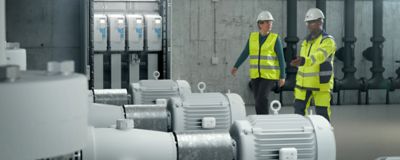Select region & language
- Europe
- Americas
- Middle East & Africa
- Asia & Oceania
Global
Austria
Bulgaria
Croatia
Czech Republic
Denmark
Estonia
Finland
France
Germany
Greece
Hungary
Ireland
Italy
Latvia
Lithuania
Luxembourg
Netherlands
Norway
Poland
Portugal
Romania
Serbia
Slovakia
Slovenia
Spain
Sweden
Turkiye
United Kingdom
Global
Argentina
Aruba
Bolivia
Brazil
Chile
Colombia
Costa Rica
Dominican Republic
Ecuador
El Salvador
Guatemala
Honduras
Mexico
Panama
Paraguay
Peru
Puerto Rico
United States of America
Uruguay
Global
Bahrain
Israel
Jordan
Kuwait
Lebanon
Oman
Pakistan
Palestine
Qatar
Saudi Arabia
South Africa
United Arab Emirates
Global
Australia
Bangladesh
India
Indonesia
Japan
Kazakhstan
Malaysia
New Zealand
Philippines
Singapore
South Korea
Sri Lanka
Taiwan (Chinese Taipei)
Thailand
Vietnam

ABB Inverter Duty Motors
Did you know…
…that most industrial electric motors in operation are more than 10 years old?
There are more than 300 million industrial electric motors at work around the world. They power a vast range of applications fundamental to our modern way of life, from industrial pumps, fans and conveyors for manufacturing and propulsion systems to compressors for electrical appliances, and heating, ventilation and air conditioning. About 45 percent of the electricity used in industry is consumed by electric motor systems, many of them old and inefficient. It is estimated that if 80 percent of the world’s electric motors were replaced with the most-efficient motors available, 160 terawatt-hours of energy would be saved per year, which is equivalent to the annual power consumption of Poland.
Replacing older motors with new, high-efficiency models is one way to improve inefficient systems, and the efficiency can be increased even more by pairing the motor with a variable speed drive. The function of such a drive is to control the energy flow to the application, adjusting constantly the frequency and the voltage supplied to the motor based on current demands. As a result, a motor can be run at an optimal speed and torque to provide the right amount of performance at any time – no more, no less.
Twenty years ago, only one drive was purchased for every 10 motors. Today that number has quadrupled, demonstrating that industry is aware of the potential of motor/drive pairings. ABB’s Baldor-Reliance® three-phase motors are “inverter duty”, which means they are designed and built to be paired with a drive, ready to be placed into new applications or as an upgrade to optimize previously installed systems. Independent research estimates that if motors in operation were replaced with optimized, high-efficiency motor-and-drive equipment, global electricity consumption could be reduced by as much as 10 percent, resulting in a 40 percent reduction in greenhouse gas emissions. It's not enough to wait until a motor needs a replacement - proactively replacing older motors with new motor-drive systems will result in reduced power consumption, longer equipment life and better process control.
Key facts:
- More than 300 million industrial electric motors are in operation around the world.
- Energy efficient motors with drives can reduce energy consumption by up to 60 percent.
- Renewing current systems could reduce greenhouse gas emissions by up to 40 percent.
Discover more about ABB’s Inverter Duty Motors: